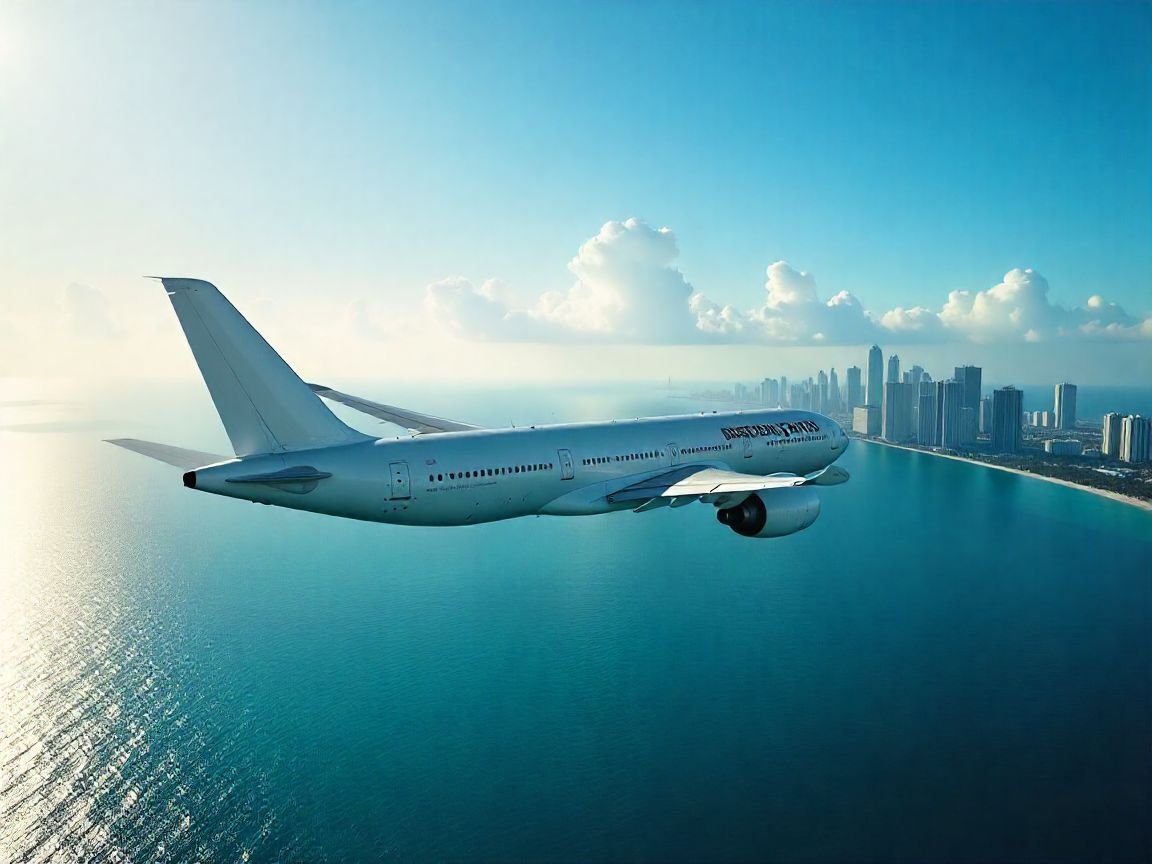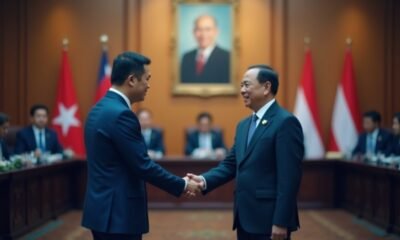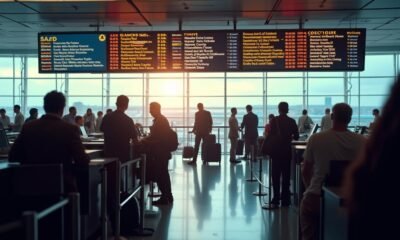Flight Buzz
American Airlines Joins LATAM, Emirates, United Airlines, Air Canada in Offering Quick International Widebody Flights, All You Need to Know

Monday, August 4, 2025
With summer travel in full swing, the US aviation sector is observing an increase in international services, with widebody aircraft utilized on 860 out of around 2400 daily flights. While widebody aircraft are known for their long-haul capabilities, they are now being used on short international routes for traveler convenience and comfort. Some of the shortest Quick International Widebody Flights are now offered by US carriers, including American and United, as well as LATAM, Emirates and Air Canada, enabling swift international travel this August.
Miami to Cancun: 1h 40m
One of the shortest international widebody flights this August is operated on the Miami to Cancun route, which has a minimum block time of just 1 hour and 40 minutes. American Airlines and LATAM are both offering widebody services on this route, with American Airlines operating a 777-200ER on select days and LATAM flying a weekly 787-8. Despite the short duration, these widebody flights provide passengers with a spacious and comfortable travel experience, making it a popular choice for those looking for a quick yet luxurious journey. These quick international widebody flights are ideal for passengers seeking efficiency without sacrificing comfort.
Miami to Punta Cana: 2h 30m
LATAM also offers another quick widebody service from Miami to Punta Cana in the Dominican Republic. The flight operates on Fridays and Saturdays, with a minimum block time of 2 hours and 30 minutes. LATAM’s 787-8 and 787-9 aircraft are utilized on this route, offering passengers a comfortable and efficient way to travel between two of the Caribbean’s most sought-after destinations. This quick international widebody flight is particularly popular among vacationers seeking a smooth and enjoyable journey.
Miami to Bogotá: 3h 35m
Emirates has introduced a daily widebody service from Miami to Bogotá, Colombia, with a minimum block time of 3 hours and 35 minutes. This service, which operates on the 777-300ER, began in June 2024 and has become an essential connection for travelers heading to and from the Colombian capital. By extending its route to Bogotá, Emirates maximizes its aircraft usage while providing a direct and quick connection between Miami and Bogotá, making it a preferred option for both business and leisure travelers. These quick international widebody flights are not only time-efficient but also provide superior comfort and service.
Los Angeles to Mexico City: 3h 45m
United Airlines operates a daily widebody service from Los Angeles to Mexico City, with a minimum block time of 3 hours and 45 minutes. The airline uses a 787-8 on this route, offering passengers a fast and comfortable way to travel between these two bustling North American cities. This service caters to the high demand for both business and leisure travel between the US and Mexico, providing an efficient solution for international travelers. These quick international widebody flights are perfect for those who need to travel between major cities without long delays.
Newark to San Juan: 4h 02m
United Airlines also operates a daily widebody service from Newark to San Juan, Puerto Rico, with a minimum block time of 4 hours and 2 minutes. Using the 767-400ER, this route connects the northeastern US with the Caribbean, providing passengers with a quick and comfortable option for travel to one of the most popular vacation destinations in the region. This quick international widebody flight ensures that passengers can make the most of their time in the Caribbean, offering both comfort and efficiency.
Icelandair’s 767 Service to Boston
Icelandair’s 767-300ER service between Boston and Keflavik has one of the longest block times for a shorter international route, at 5 hours and 15 minutes. Still, the flight is vital for connecting European passengers with the United States. Icelandair has been able to use the 767-300ER to haul passengers and cargo, making the most of the aircraft’s capacity. The demand for travel in the summer season is particularly high, which is when Icelandair and other carriers need the capacity most. These international widebody flights are critical in making certain there is fast access to travel and the Atlantic Ocean can be crossed in a fraction of the time, regardless of the direction.
The Icelandair service is representative of the fleet of widebody aircraft, for in most cases these planes are employed on longer journeys. However, for airlines like American Airlines, LATAM, Emirates, United Airlines and Air Canada, providing fast widebody legs internationally, these planes provide a competitive advantage and may lead to increased market share. The shift to more fast, high-capacity services overseas is targeted at providing more options to travelers, which is welcomed in this coming August.
Flight Buzz
Thiruvananthapuram Eyes Direct Flights to Thailand, Vietnam

Thiruvananthapuram International Airport is preparing to launch direct flights to Thailand and Vietnam in response to increasing demand from travellers. The move is set to significantly improve connectivity, reduce travel time, and enhance access to two of Southeast Asia’s most popular destinations.
Currently, passengers must take connecting flights via hubs such as Kuala Lumpur or Singapore, often adding over 10 hours to their journey. The proposed direct flights—reducing travel time to approximately five hours—will not only streamline transit but also encourage greater tourism and business activity between Kerala and Southeast Asia.
Airport authorities have confirmed they are in advanced discussions with multiple airlines and relevant regulatory bodies. Several carriers have shown interest in expanding operations from the city, including launching new routes and increasing flight frequencies to Thailand and Vietnam. Tour operators report growing interest from travellers exploring the region, especially to Ho Chi Minh City, with many combining trips to Vietnam and Cambodia.
This initiative is part of a broader strategy to enhance Thiruvananthapuram’s status as a major international hub. The airport currently offers direct flights to destinations including Dubai, Singapore, Kuala Lumpur, Doha, Sharjah, Muscat, Abu Dhabi, Dammam, and the Maldives. The addition of Southeast Asian routes will further elevate its network reach.
With rising international passenger volumes, airport authorities are investing in service upgrades and infrastructure expansion. Passenger traffic is expected to grow from current levels to approximately 3.96 million by 2030, 5.32 million by 2040, and 11.45 million by 2070.
Improved air links are also expected to generate broader economic benefits. Increased international tourist arrivals will support the local economy through growth in hospitality, retail, logistics, and manufacturing sectors. Enhanced trade ties with Southeast Asia could also attract investment in technology and industrial development.
This connectivity initiative aligns with wider regional development goals and positions Thiruvananthapuram as a key gateway for international movement of people and goods. As Southeast Asia continues to emerge as a global economic powerhouse, stronger air links will be essential for sustaining growth and prosperity across the region.
Flight Buzz
Weekend wanderlust

Young professionals across China take advantage of cheap flights, visa policies to regularly travel overseas
In Stark’s world, Friday nights usually mean going to the airport to get an international flight out of the country and returning on Monday morning, ready to head straight to work.
The 20-something Shanghai-based tech professional, who prefers to keep his real name private, has proved that you do not need to take a gap year or quit your job to travel the world.
In recent years, he has spent nearly every weekend traveling to more than 60 countries, some of them multiple times. By using different time zones and tight layovers to his advantage, he recently turned a mid-June weekend into a 42-hour Hawaiian escape without taking a day off work.
After a hop from Shanghai to Tokyo and an overnight flight across the Pacific, Stark landed in Honolulu on what was still Friday morning local time. Thanks to Hawaii’s 18-hour time difference with Beijing, he was gifted a “second Friday”.
At sunrise on Saturday, he joined early-bird hikers ascending Diamond Head — one of Honolulu’s most iconic volcanic craters. “It’s a favorite among hikers,” he noted, “and a perfect spot to view the city skyline.”
That afternoon, Stark booked a small island loop tour. From the golden stretches of Waikiki Beach to the rugged southeastern coastline, the bus made several scenic stops — each lookout revealing dramatic beauty.
Later, he visited Pearl Harbor, where the history of World War II casts a long shadow.
Stark, who works overtime to finance his travels, had arrived just in time for ongoing celebrations to mark King Kamehameha Day, one of Hawaii’s most important holidays.
He joined crowds lining the sidewalks of Honolulu as flower-draped floats and grass-skirted dancers paraded past in celebration of the king who unified the islands. “It was like watching history and festivities dance together,” he said.
However, by 2 am on Monday, he was back in Shanghai in time to go to work.
Professionals like Li Xiaojin, who works at a biopharmaceutical company in Beijing, are also redefining weekend travel. He often jets off to another country after a week’s work — sometimes without taking a full day off.
“I might leave work just two hours early on Friday, fly to Japan or Thailand, and be back by Monday morning in time to go straight to the office,” said Li, who is in his 30s.
His travel frequency has soared in recent years, and he has got the hang of making the most of his weekends abroad. For him, international weekend trips are about escaping familiarity.
“Everything is different from home. The food, the people, the streets. It’s that novelty that makes it worthwhile,” he said.
“Last year, I was going abroad once every one or two months. Now, I might travel almost every month,” he said.
His weekend trips take full advantage of the time he has available.
“No layovers, no long flights,” he said. “Two to three hours is ideal — Thailand, Japan, and Vladivostok (in Russia). That’s the limit. Once I took a Friday night flight to Shenyang, stayed overnight, then flew to Nagoya (central Japan). On the way back, I had to transit through Shanghai. Never again.”
Despite the rapid pace of his weekend outbound trips, Li does not stress over planning.
“I don’t go to a destination with a checklist. I just walk around, eat, and relax. It’s about unwinding, not cramming in attractions,” he said.
His recent getaways included Sri Lanka over Qingming Festival and Uzbekistan during the Labor Day holiday. “I don’t really care where I go — wherever it is cheap, I’ll fly. If the price and time are right, I’ll go,” he said matter-of-factly.
A rising number of China’s young professionals have shown a desire to spend weekends traveling abroad, fueled by budget flights, visa-friendly policies, and a yearning for a new experience.
Zhao Nan, general manager of the industry development department at the popular aviation service app Umetrip, said weekend outbound travel has seen a clear upward trend in recent years.
“Since 2023, with the steady recovery of international flights and increased visa facilitation, demand for short-haul cross-border trips has surged,” Zhao said.
Popular departure cities are mainly first-tier and emerging first-tier cities, with travelers placing greater emphasis on travel time, making neighboring Asian countries the preferred choice, he explained.
Outbound passenger volume from Friday to Sunday typically exceeds weekday levels, with “Friday evening departure, Sunday night return” becoming the norm, according to Umetrip’s big data monitoring.
“As international flight routes continue to expand, weekend outbound travel is expected to become increasingly routine, particularly in economically developed regions with well-connected transport hubs,” Zhao said.
The growing appeal of weekend getaways abroad is evident in Stark’s large following on the social media platform Xiaohongshu, or RedNote, where he began sharing his outbound travel experiences a few years ago with his 50,000 fans.
His travel philosophy has been to let curiosity lead the way.
For instance, part of the reason for his recent trip to Hawaii was to coincide with the local festivals.
Stark’s obsession with travel began in college, when he started taking rides on the country’s slow-moving green trains.
“Back then, I didn’t really enjoy staying on campus during weekends,” he recalled. “Sometimes I’d hop on a cheap train just to get away.”
When he discovered low-cost red-eye flights, his range widened. His first international weekend trip was to the Philippines, with a round-trip ticket purchased for less than 400 yuan ($55.80).
He did not ask his parents for money, but juggled schoolwork with freelance programming gigs to fund his getaways.
After graduation, Stark maintained a routine of taking a weekend trip every two weeks, which later evolved into weekly travel.
He made use of discount airline packages like China Eastern Airlines’ unlimited flight pass, and developed a keen eye for the best budget flights.
“My rule is, if a weekend trip’s flight costs more than 4,000 yuan, I will pass,” he said.
After China reopened its borders following the COVID pandemic, Stark resumed his traveling with renewed energy. Since then, he extended his travel range, including visits to Australia, the Netherlands, and the United Kingdom within one month. Last year alone, he visited 43 countries.
Some skeptics describe his travel style as “superficial” or “rush-hour tourism”, but Stark shrugs off the criticism.
“I don’t think travel depth depends on time,” he explained.
“You can break a long trip into multiple visits. I’ve been to Paris three times — each trip focused on something different.”
He once traveled close to the Arctic Circle just to sit inside the world’s northernmost McDonald’s restaurant for 15 minutes. “For many, it’s about experiencing a symbolic location. I didn’t need more than that,” he said of the trip.
He contrasts that with his other experiences, like waiting three hours on a windy hilltop to capture a time-lapse photograph of the sunset at Santorini in Greece.
Li, the biopharma professional, planned to make a short trip to Kuching in Sarawak, Malaysia, in July.
“I’ll just take one day off — it’s a three-day trip,” he said. “You only have so many weekends in a year. Why not make the most of them?”
“Staying at home over the weekend, time flies by. But if I’m traveling abroad, even just for two days, they will then feel full and long — it stretches the weekend. That’s why I love it,” he added.
Places like Southeast Asia and East Asia are ideal — short flights, easy visas, and low costs. Some round-trip tickets cost him less than 2,000 yuan. “You can’t beat that,” he said.
Zhang Guangyu, associate professor at the School of Tourism, History, and Culture of Southwest Minzu University, considers the rise of such “commando-style cross-border travel” a new form of consumption and a mirror of societal transition.
The rapid expansion of international flight networks and streamlined border procedures has made high-frequency travel possible, which is unlocking young consumers’ spending potential, Zhang said.
Explaining the popularity of such high-intensity travel, he said he believes it is not just a way of exploring the world but a form of social currency. Whether strolling foreign streets or venturing to the poles, these experiences are easily shared via short videos, reinforcing group identity and trend affiliation, Zhang said.
At the same time, under the pressure of fast-paced work and a culture of overachievement, young people can seize control of their limited free time through busy itineraries, treating travel as an emotional antidote and temporary escape from reality, he added.
With the arrival of the summer travel peak, many airline companies have increased or rolled out new outbound flights in response to this shift in travel behavior.
Air China plans to optimize capacity and increase the frequency of direct flights on popular routes such as one connecting Chengdu in southwestern Sichuan province with Singapore.
The airline will also launch tailored promotions, including outbound travel voucher packages and special offers for Thailand’s Songkran Festival, according to a representative from Air China.
Sichuan Airlines will offer additional promotional products for flights departing from Chengdu, such as flexible flight passes.
Weekend travelers can expect further incentives, including bonus mileage accumulation and flexible ticket changes and refund policies, aimed at making short-haul international travel more accessible and traveler-friendly, according to an official from Sichuan Airlines.
Far from being impulsive, Stark’s approach is meticulously calculated. He scans ticket prices, matches travel duration to affordability, and makes real-time adjustments based on seasonal trends. “I usually spend about 50 percent of my income on travel,” he said.
Despite his passion for travel, he insists that work always comes first.
“People assume I slack off, but I’ve never let travel affect my job performance. I plan around deadlines, work extra hours if needed, and skip trips when necessary,” he explained.
His work colleagues and managers not only support him, but were the ones who first suggested he start posting his stories online.
While maintaining a big fan base, Stark does not consider himself a full-time content creator. “Filming is secondary. I always prioritize the experience. For some trips, I don’t make them into videos — just written notes,” he said.
He occasionally receives sponsored travel offers, but most trips remain self-funded.
“I prefer it that way. The freedom matters,” he said.
To those hoping to follow in his footsteps, Stark offers simple advice: “You don’t need to travel like me. Just do what excites you. Some people love football, some love skateboarding — I happen to love changes of scenery and motion.”
He said he does not plan to slow down his hectic weekend travel unless the joy fades from it: “As long as I still find meaning in it, I’ll keep going.”
Contact the writer at yangfeiyue@chinadaily.com.cn
Flight Buzz
Traveller’s seatbelt trick for ‘sleeping like a baby’ on long flights prompts warning: ‘Scared’

There are so many amazing things about taking an overseas holiday. You get to experience new and intriguing places, try new cuisines, see sights you might be familiar with from movies and hopefully switch off from the demands of life for a while.
Although Aussies love to travel and are known as a fairly intrepid bunch, it cannot be denied that taking an international trip from Down Under to pretty much anywhere can be torturous because it takes so damn long! And, if you are in an economy seat, it can feel like even longer.
It’s no wonder that travellers will go to the ends of the earth trying to find ways to make long-haul flights bearable and to find travel hacks that promise a decent stretch of sleep.
However, after one tourist shared a controversial travel hack for sleeping on flights, her followers expressed concerns about the trick’s safety, and a vascular surgeon tells Yahoo Lifestyle that she would not recommend it.
In a TikTok that has been viewed 560k times, Lindsay (@linzi_who) demonstrates the unusual position she found that helped her get some rest on a flight.
RELATED:
Traveller’s flight sleep hack divides
“Now this is the travel hack we all need to know,” she says in the clip. “Extend the seatbelt as far as you can, put your legs up, wrap it around your ankles, plug it in and look nice and tight. Then I turn sideways, put my head against the back of the chair, and honestly, I slept like a baby.”
While Lindsay says the hack “made sleeping on the plane so much easier”, the video attracted more than 200 comments from people who saw nothing but issues.
“I’m 5ft 11, no chance I could do that lol,” one person said while someone else said it wouldn’t work for them as they are 6’2.
“I mean that would never work for us plus-sized girlies 😩😩😩,” another person lamented.
“My knees after that would a hundred per cent not stretch out without a cry of pain and help 💀😂,” someone else added.
“Hard to do when you have your 9-month-old on your lap 😂😂,” was another comment.
Another person said that they “got told off” when they attempted the trick.
Other travellers were more open to the idea, with a couple of them saying they intended to try the trick themselves on their next flight.
“I do this without turning to the side, and it was the most comfortable way I’ve found on long-haul flights,” one person commented.
Travellers concerned about risks of flight hack
There were also plenty of comments from people who said that they would be too concerned about deep vein thrombosis (DVT) to attempt the seat hack.
DVTs (blood clots) can occur when people sit still for long periods of time, as this slows down blood flow in the legs. A lack of movement greatly increases the chances of a clot forming, and if that blood clot breaks loose, it can travel through the bloodstream to the lungs, causing a blockage called a pulmonary embolism, which can be life-threatening.
“I’d be too scared of DVT,” one said.
“Yeah, like you don’t higher the risk of a blood clot when you travel like this. Good luck,” added another.
“Enjoy your DVT,” a third wrote while someone else commented, “DVT… 🤔 You shouldn’t sit like that on an aeroplane.”
Expert’s warning over dangerous seat hack
Dr Pecky De Silva, a vascular surgeon and Councillor at the Royal Australasian College of Surgeons, tells Yahoo Lifestyle that the detractors of the travel hack are absolutely right and that staying in that position could indeed be dangerous.
“The practice shown on the video would increase your risk of deep venous thrombosis because of the immobility of the limbs held in place by the safety belt, but also because of the position of the legs, causing compression of the major deep vein behind the knee,” she tells us.
And, replying to the many viewers of the TikTok who wondered about the safety of the trick during turbulence, Dr De Silva says she agrees with them too.
“My other concern would be that during severe turbulence, the safety belt wouldn’t keep you safe, and you would be at risk of flying up and hitting your head,” she says. “Altogether, I would definitely be advising my patients against this practice.”
How to prevent DVT on long haul flights
If you are lucky enough to have an international flight coming up, there are several things you can do to minimise the risk of DVT.
SHOP:
For starters, you should wear comfortable and loose fitting clothes (pretty standard attire for a long flight anyway) so you can move freely. However, wearing compression socks is a great idea too – particularly for anyone who is at a higher risk of clots, such as women on the birth control pill.
And, although it can be so tempting to relax with a few glasses of wine during your flight (you are on holiday, after all!), it is recommended that caffeine, alcohol and sleeping pills be avoided. Instead, try to drink plenty of water which will keep you hydrated and could even help to minimise jet lag.
And, of course, it’s important to try to get up and move around as much as possible during the flight to increase circulation and prevent muscle soreness and stiffness.
-

 Brand Stories2 weeks ago
Brand Stories2 weeks agoBloom Hotels: A Modern Vision of Hospitality Redefining Travel
-

 Brand Stories1 week ago
Brand Stories1 week agoCheQin.ai sets a new standard for hotel booking with its AI capabilities: empowering travellers to bargain, choose the best, and book with clarity.
-

 Destinations & Things To Do2 weeks ago
Destinations & Things To Do2 weeks agoUntouched Destinations: Stunning Hidden Gems You Must Visit
-

 Destinations & Things To Do1 week ago
Destinations & Things To Do1 week agoThis Hidden Beach in India Glows at Night-But Only in One Secret Season
-

 AI in Travel2 weeks ago
AI in Travel2 weeks agoAI Travel Revolution: Must-Have Guide to the Best Experience
-

 Brand Stories1 month ago
Brand Stories1 month agoVoice AI Startup ElevenLabs Plans to Add Hubs Around the World
-

 Brand Stories3 weeks ago
Brand Stories3 weeks agoHow Elon Musk’s rogue Grok chatbot became a cautionary AI tale
-

 Asia Travel Pulse1 month ago
Asia Travel Pulse1 month agoLooking For Adventure In Asia? Here Are 7 Epic Destinations You Need To Experience At Least Once – Zee News
-

 AI in Travel1 month ago
AI in Travel1 month ago‘Will AI take my job?’ A trip to a Beijing fortune-telling bar to see what lies ahead | China
-

 Brand Stories2 weeks ago
Brand Stories2 weeks agoContactless Hospitality: Why Remote Management Technology Is Key to Seamless Guest Experiences













You must be logged in to post a comment Login